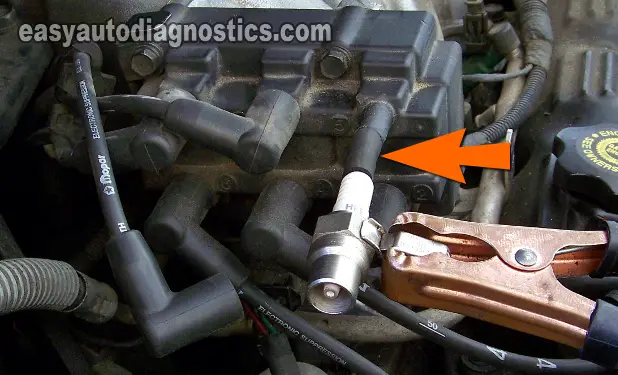TEST 3: Testing For Spark At The Ignition Coil Pack
In this test step, your mission is to test for spark directly on the ignition coil pack towers that feed spark to the two spark plug wires (of paired cylinders) that did not fire off spark in TEST 1.
You'll test one tower first and then test the other. The correct test result is for both towers to spark.
If both towers don't spark, then you can conclude that the ignition coil is defective and needs to be replaced.
Let's get started:
- 1
Remove the spark plug wire that did not fire off spark from the ignition coil pack.
- 2
Place the spark tester directly on the ignition coil tower using a small piece of vacuum hose.
IMPORTANT: It is crucial that you use this piece of vacuum hose! (see photos in the image viewer). - 3
Connect the spark tester to the battery negative (-) terminal with a jump start cable (see photo).
- 4
Have your helper crank the engine.
CAUTION: The engine may start, so be careful. - 5
You're gonna' get one of two results:
1.) Spark.
2.) No spark. - 6
Disconnect the HEI spark tester from the ignition coil tower and reconnect its spark plug wire.
- 7
Repeat tests 1 thru' 6 on the other ignition coil tower whose spark plug wire did not fire off spark.
Let's see what your test results mean:
CASE 1: You got spark from only one tower. This result lets you know that the ignition coil is bad. Replace the ignition coil.
Here's why: Both ignition coil towers fire spark simultaneously to their 'paired' cylinders. Since only one of both towers is sparking, the ignition coil is bad and needs replacement.
CASE 2: You got spark from both towers. This result lets you know that the ignition coil is good and that the spark plug wires are bad. Replace all of the spark plug wires as a set.
CASE 3: You got NO spark from both towers. This usually means that the Switching signal for those two towers is missing.
The next step is to test for the Switching signal for that particular ignition coil (within the coil pack) that owns the two towers you just got done testing by choosing one of the following:
- If you got NO spark from the towers that feed spark to cylinders 1 and 4, go to: TEST 5: Switching Signal Test For Cylinders 1/4.
- If you got NO spark from the towers that feed spark to cylinders 2 and 5, go to: TEST 6: Switching Signal Test For Cylinders 2/5.
- If you got NO spark from the towers that feed spark to cylinders 3 and 6, go to: TEST 7: Switching Signal Test For Cylinders 3/6.
TEST 4: Testing The Power (12 Volts) Circuit

In this test section, we're gonna' make sure the ignition coil pack is getting power.
You can use a multimeter or a 12 Volt test light to test the power (12 Volt) circuit of the Chrysler coil pack.
To get an accurate test result, I recommend that you use a multimeter.
Alright, these are the test steps:
- 1
Disconnect the ignition coil from its electrical connector.
- 2
Put the multimeter in Volts DC mode.
Don't have a digital multimeter and need to buy one, see my recommendations here: Buying A Digital Multimeter For Automotive Diagnostic Testing. - 3
Probe the wire labeled with the number 3 with the red multimeter test lead (using an appropriate tool to pierce the wire).
NOTE: The 4 wires in the ignition coil pack's connector are usually sheathed in black electrical tape that has probably turned plastic hard, remove enough of this electrical tape to expose the three wires for testing - 4
Connect the black multimeter test lead to the battery negative (-) terminal.
- 5
Have your helper turn the key to the ON position and then crank the engine.
NOTE: Continuous voltage is only provided when the engine is being cranked. - 6
You should see 10-12 Volts on your multimeter. If you're using a 12 Volt test light, it should light up.
Let's see what your test results mean:
CASE 1: The multimeter registered 10 to 12 Volts DC. This is the correct test result. then the next step is verify that the Switching signals are present.
Your next step is to go to TEST 5, then TEST 6, and then TEST 7.
If the all three Switching signals are not present (after testing them in TEST 5, TEST 6, and TEST 7), the most likely cause will be that there's an open-circuit problem in the engine wiring harness or a bad connector somewhere in the engine harness.
CASE 2: The multimeter DID NOT register 10 to 12 Volts DC. Re-check all of your connections and retest.
If still no voltage is present, this result exonerates the coil pack. Repairing the cause of this missing voltage will solve the 'no-spark no-start' condition of your Chrysler (or Dodge or Plymouth) mini-van. The most common reasons for no power are:
- The crankshaft position (CKP) sensor is bad. If the CKP sensor is bad, the PCM will not power up the Auto Shut Down (ASD) Relay, which in turn will not power up the ignition coil pack or any other ignition system or fuel system component. You can find the CKP sensor test here:
- How To Test The Crank Sensor -No Spark No Start Tests (Chrysler 3.0L, 3.3L, 3.8L) (at troubleshootmyvehicle.com).
- A bad Auto Shut Down (ASD) Relay.
- A blown fuse.


